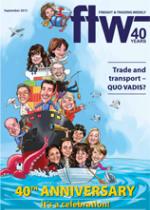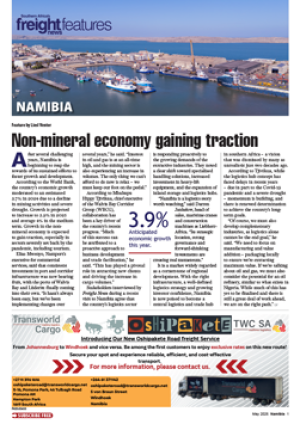From the golden era of rail
when almost no freight
moved on road to the
opposite scenario today
where the country stops when
trucks don’t move – road and rail
have been at loggerheads for far
too long.
The road versus rail debate has
been part and parcel of the freight
industry for as long as most can
remember –
dating back to
the late 1930s
when rail first
started losing
customers to
the rapidly
developing
road transport
industry.
Koos Smit,
engineering
executive for the
South African National Roads
Agency Limited (Sanral), says the
significant growth in wealth and
development that followed the
end of the Second World War was
arguably the beginning of the end
for rail.
In South Africa it remained a
protected monopoly. But rising
consumer demand continued to
create a need for faster deliveries
and lower inventories while the
world saw the birth of the just-intime
approach
within the supply
chain.
Professor
Jan Havenga,
director of
the Centre for
Supply Chain
Management at
the University
of Stellenbosch,
says all of this
played a role in
the ultimate demise of rail – and
its protected status was both an
asset and liability.
“Being a common carrier it
meant that everything had to
be transported, so if someone
wanted to transport one can
of milk between two railway
stations, the railway was forced
to provide the service, often
at highly subsidised low rates
which were published in a tariff
book. These practices led to
the cross-subsidisation of rural
traffic by high-value high-volume
traffic on corridors and a backlog
in rail corridor infrastructure
development,”
he says. “Road
in this period
provided a
delivery service
from the rail
endpoints,
with the largest market share
and biggest road vehicle f leet
belonging to the railway.
“The road transport landscape
is very different today from
what it was 40 years ago,” says
Havenga. “Road transport
efficiency has improved largely
due to vehicle and pavement
improvement. Higher allowable
vehicle mass and improved
scheduling have increased load
factors and therefore lowered
costs. Two major drivers were
more outsourcing to logistics
service providers that provided
natural freight consolidation and
better return loads, and more
maturity in the freight logistics
industry – in
other words
larger firms
with better
practices
of safety,
quality and
equipment replacement and
maintenance.”
At the same time there were
huge developments in freeway
infrastructure, mostly paid for
by non-freight road users and
government. This investment and
development occurred at the same
time as deregulation of the freight
transport industry without
proper or full implementation of
the RTQS.
“So whilst road transport
efficiency and road infrastructure
development have improved
dramatically over the past 40
years, this has led to an increase
in heavy traffic on roads with a
concomitant rise in externality
and logistics costs to the country.”
Says Smit: “It was not entirely
unexpected that the success of
road transport would later lead to
widespread road
deterioration,
congestion,
pollution and
road safety
problems,
although, in
fairness, not all
of these problems
are solely
attributable to
heavy vehicles.
However, we
must still ask
the question – whether or not the
number of heavy vehicles on our
roads is in our best interests.”
Experts agree that the future
lies in intermodal. Neither road
nor rail can be king.
“Corridor long-haul freight
must shift to rail or the cost
and supply risk as well as
environmental concerns relating
to imported fuel will erode South
Africa’s competitiveness.”
Smit agrees, saying a vast
amount of research and long-term
planning has been undertaken –
all of which indicates that there
are certain goods currently being
transported by road that could be
more economically transported
by rail provided
that the backlog
in investment in
the rail systems
is addressed.
“We are
pleased that
government
has announced
significant
investment in
rail transport
and that its
focus is on
attracting goods off roads
that can logically and more
economically be transported by
rail,” says Smit. “However, our
expectations are that this will
only improve the situation on
freight corridors that are served
by both road and rail and will not
significantly reduce the number
of heavy vehicles on roads for
which there is no rail competitor.”
For Havenga the next natural
step would be to address the
low-density lines issues as
well. “Creative solutions will be
needed to allow these lines to be
preserved – but at the same time
remove the drain on the railway’s
resources,” he said.
INSERT
R400bn
The annual cost of logistics in SA.
INSERT & CAPTION 1
We must ask the question
— whether or not the
number of heavy vehicles
on our roads is in our best
interests.
– Koos Smit
INSERT & CAPTION 2
Higher allowable vehicle
mass and improved
scheduling have increased
load factors and therefore
lowered costs.
– Jan Havenga
CAPTION
Corridor long-haul freight must shift to rail or the cost and supply risk as well
as environmental concerns relating to imported fuel will erode South Africa’s
competitiveness.

